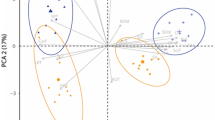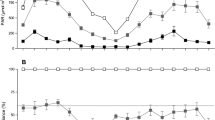Abstract
Forest nurseries use different greenhouse light sources including new light technologies to produce conifer seedlings without knowing their real impact on subsequent field performance. The aim of the experiment was to investigate whether different growth light spectra during pre-cultivation of Scots pine and Norway spruce seedlings under controlled conditions affect growth and morphology of seedlings, and whether the possible differences between the treatments will be maintained after outplanting to a field site. The seedlings were pre-cultivated for 5.5–6.5 weeks in a darkened greenhouse under four light spectra consisting of different proportions of blue (B, 400–500 nm), red (R, 600–700 nm), and far-red (FR, 700–800 nm), with high-pressure sodium lamps (HPS) serving as controls. The light treatments (250 µmol m−2 s−1 photosynthetically active radiation) were provided using light-emitting diodes, and the treatments included the following: (1) 25 % B + 70 % R + 5 % FR; (2) 25 % B + 75 % R; (3) 55 % B + 45 % R; and (4) HPS: 6 % B + 44 % green (500–600 nm) + 41 % R + 9 % FR (control). Growth and morphology were studied at the time of transplanting in spring, and again, at the time of outplanting the seedlings in the field site in autumn. Growth, survival and phenology of the seedlings were followed in the field for 1 year. Growth and morphology of the seedlings were modified by the different growth light spectra during pre-cultivation, but by the time of outplanting, these differences between the treatments had disappeared. In conclusion: Growth and morphology of seedlings can be modified by adjusting the spectral composition of growth light during pre-cultivation, but the modifications may not be long-lasting.



Similar content being viewed by others
References
Apostol KG, Dumroese RK, Pinto JR, Davis AS (2015) Response of conifer species from three latitudinal populations to light spectra generated by light-emitting diodes and high-pressure sodium lamps. Can J For Res 45:1711–1719
Arnott TA (1984) Photoperiod control of container seedlings. In: Proceedings of the Western Forest Nursery Council and Intermountain Nurseryman’s Association. Coeur d’Arlene, ID, 14–16 August 1984. Edited by Landis TD. USDA Forest Service, Ogden, Utah, General Technical Report INT-185, pp. 9–13
Clapham DH, Dormling I, Ekberg I, Eriksson G, Qamaruddin M, Vince-Prue D (1998) Latitudinal cline requirement for far-red light for the photoperiodic control of bud set and extension growth in Picea abies (Norway spruce). Physiol Plant 102:71–78
Cope KR, Snowden MC, Bugbee B (2014) Photobiological interactions of blue light and photosynthetic photon flux: effects of monochromatic and broad-spectrum light sources. Photochem Photobiol 90:574–584
de la Rosa TM, Aphalo PJ, Lehto T (1998) Effects of far-red light on the growth, mycorrhizas and mineral nutrition of Scots pine seedlings. Plant Soil 201:17–25
Demotes-Mainard S, Péron T, Corot A, Bertheloot J, Le Gourrierec J, Pelleschi-Travier S, Crespel L, Morel P, Huché-Thélier L, Boumaza R, Vian A, Guérina V, Leduc N, Sakr S (2016) Plant responses to red and far-red lights, applications in horticulture. Environ Exp Bot 121:4–21
Fløistad IS, Patil GG (2002) Growth and terminal bud formation in Picea abies seedlings grown with alternating diurnal temperature and different light qualities. Scand J For Res 17:15–27
Folta KM, Spalding EP (2001) Opposing roles of phytochrome A and phytochrome B in early cryptochrome-mediated growth inhibition. Plant J 28:333–340
Grossnickle SC (2012) Why seedlings survive: influence of plant attributes. New For 43:711–738
Heiskanen J (1999) Hydrological properties of container media based on sphagnum peat and their potential implications for availability of water to seedlings after outplanting. Scand J For Res 14:78–85
Hoddinott J, Scott R (1996) The influence of light quality and carbon dioxide enrichment on the growth and physiology of seedlings of three conifer species. I. Growth responses. Can J Bot 74:383–390
Juntunen ML, Rikala R (2001) Fertilization practice in Finnish forest nurseries from the standpoint of environmental impact. New For 21:141–158
Landis TD, Tinus RW, McDonald SE, Barnett JP (1992) The Container Tree nursery manual. Atmospheric environment, Washington, DC: U.S. Department of Agriculture, Forest Service. Agricultural handbook 674. Vol. 3. 145 p
Landis TD, Dumroese RK, Haase DL (2010) The Container Tree nursery manual. Seedling processing, storage and outplanting. Washington, DC: U.S. Department of Agriculture, Forest Service. Agricultural handbook 674. Vol. 7. 199 p
Luoranen J, Konttinen K, Rikala R (2009) Frost hardening and risk of second flush in Norway spruce seedlings after an early-season short-day treatment. Silva Fenn 43:235–247
Luoranen J, Sutinen S, Rikala R (2010) Predicting spring frost sensitivity by bud development and temperature sum in Norway spruce seedlings. Trees 24:809–817
Mattsson A, Radoglou K, Kostopoulou P, Bellarosa R, Simeone MC, Schirone B (2010) Use of innovative technology for the production of high-quality forest regeneration materials. Scand J For Res 25:3–9
Mølmann JA, Junttila O, Olsen JE (2006) Effects of red, far-red and blue light in maintaining growth in latitudinal populations of Norway spruce (Picea abies). Plant Cell Environ 29:166–172
Morgan DC, Rook DA, Warrington IJ, Turnbull HL (1983) Growth and development of Pinus radiata D. Don: the effect of light quality. Plant Cell Environ 6:691–701
Nilsson U, Luoranen L, Kolström T, Örlander G, Puttonen P (2010) Reforestation with planting in northern Europe. Scand J For Res 25:283–294
Pierik R, de Wit M (2014) Shade avoidance: phytochrome signaling and other aboveground neighbor detection cues. J Exp Bot 65:2815–2824
Riikonen J, Kettunen N, Gritsevich M, Hakala T, Tahvonen R (2016) Growth and development of Norway spruce and Scots pine seedlings under different light spectra. Environ Exp Bot 121:112–120
Sarala M, Taulavuori E, Karhu J, Laine K, Taulavuori K (2011) Growth and pigmentation of various species under blue light depletion. Boreal Environ Res 16:381–394
Simpson DG, Ritchie GA (1996) Does RGP predict field performance? A debate. New For 13:249–273
Singh D, Basu C, Meinhardt-Wollweber M, Roth B (2015) LEDs for energy efficient greenhouse lighting. Renew Sustain Energy Rev 49:139–147
Whitelam GC, Halliday KJ (2007) Light and plant development. Annual Plant Reviews, vol 30. Blackwell Publishing, Oxford
Wollaeger HM, Runkle ES (2013) Growth responses of ornamental annual seedlings under different wavelengths of red light provided by light-emitting diodes. HortScience 48:1478–1483
Acknowledgments
This study was funded by the European Social Fund (ESF, project S11890) and the Finnish Forest Research Institute (project 3554). I would like to thank Dr. Risto Rikala for his valuable comments on the manuscript, and the staff of the research nursery in the Natural Resources Institute Finland, Suonenjoki unit, for maintaining the experiment.
Author information
Authors and Affiliations
Corresponding author
Rights and permissions
About this article
Cite this article
Riikonen, J. Pre-cultivation of Scots pine and Norway spruce transplant seedlings under four different light spectra did not affect their field performance. New Forests 47, 607–619 (2016). https://doi.org/10.1007/s11056-016-9533-9
Received:
Accepted:
Published:
Issue Date:
DOI: https://doi.org/10.1007/s11056-016-9533-9




